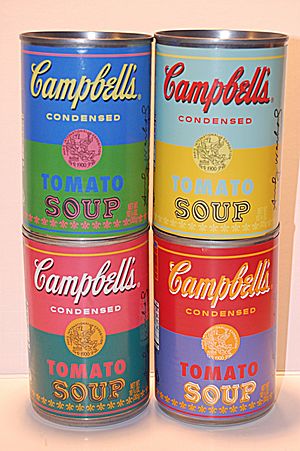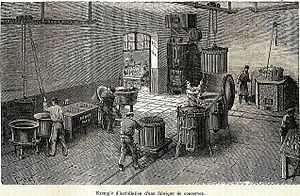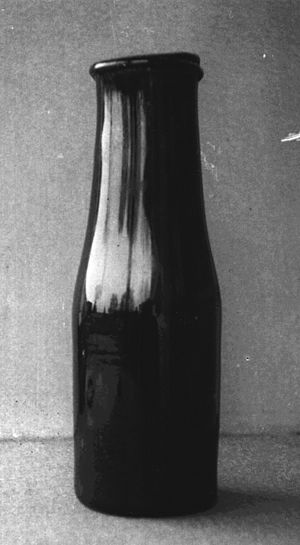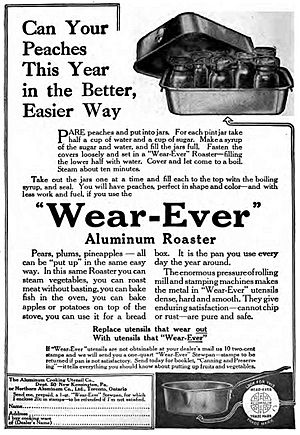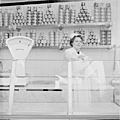Canning facts for kids

Canning is a way to keep food fresh for a long time. Food is cooked and then sealed in an airtight container. These containers can be jars (like Mason jars) or steel and tin cans.
Canned food usually stays good for one to five years. Some special canned foods, like dried lentils, can last up to 30 years! In 1974, scientists tested canned food from a steamboat that sank in 1865. The 109-year-old food was still safe to eat, even though it didn't look or smell great.
Contents
History of Canning: How it Started
French Beginnings
During the Napoleonic Wars, the French government wanted a way to feed its large army. They offered a big prize of 12,000 francs to anyone who could invent a cheap and good way to preserve lots of food. Armies needed more food, and getting enough food often stopped them from fighting in winter.
In 1809, a French candy maker and brewer named Nicolas Appert noticed something. Food cooked in a jar didn't go bad if the jar was sealed tightly. He created a way to seal food in glass jars. Appert won the prize in 1810. At that time, no one knew why the food didn't spoil. It took another 50 years for Louis Pasteur to discover tiny living things (microbes) that make food spoil.

The French Army tried giving canned food to its soldiers. But canning was slow, and it was hard to move large amounts of food. The war ended before the process was perfect. After the Napoleonic Wars, canning slowly spread to other countries in Europe and the United States.
Canning in the United Kingdom
Based on Appert's ideas, the tin can was developed. A Frenchman named Philippe de Girard came to London. He had a British merchant, Peter Durand, patent his idea in 1810. Durand then sold his patent to Bryan Donkin and John Hall in 1811.
Bryan Donkin improved the process of putting food into sealed, airtight cans. These cans were made of tinned iron. At first, canning was slow and took a lot of work. Each large can was made by hand and took up to six hours to cook. This made canned food very expensive for most people.
The main customers for canned food were the British Army and Royal Navy. By 1817, Donkin had sold £3000 worth of canned meat in six months. Explorers like Sir William Edward Parry and Sir John Franklin took canned food on their trips to the Arctic. Some of Franklin's canned food was found in 1857. One can was opened in 1939 and the food was still good to eat!
Canning in Europe
In the mid-1800s, canned food became a special item for middle-class families in Europe. It was seen as a new and interesting thing. Early cans were sealed using lead solder, which could be harmful.
As machines improved, canning became faster and cheaper. More people moved to cities in Europe, and they needed easy-to-store food. By the 1860s, smaller, machine-made steel cans were possible. The time needed to cook food in sealed cans dropped from six hours to just thirty minutes.
Canning in the United States
Canned food also became popular outside Europe. Robert Ayars opened the first American canning factory in New York City in 1812. He canned oysters, meats, fruits, and vegetables.
Demand for canned food grew a lot during wars. Big wars in the 1800s, like the American Civil War, meant more working-class men tried canned food. Canning companies grew to meet the army's needs for food that wouldn't spoil. After the wars, these companies could sell their products to more people.
In Victorian Britain, city people wanted more cheap, varied, and good quality food. They wanted food they could keep at home without shopping every day. Companies like Underwood, Nestlé, and Heinz started selling good canned food to city dwellers. By the late 1800s, there were many more types of canned food. Companies competed with new foods, colorful labels, and lower prices.
Canning During World War I
During World War I, the need for canned food exploded. Army leaders needed huge amounts of cheap, high-calorie food for millions of soldiers. This food had to be easy to transport, survive trench conditions, and not spoil.
At first, British soldiers mostly ate low-quality canned foods. These included "Bully Beef" (cheap corned beef), pork and beans, and canned sausages. But by 1916, soldiers were unhappy with the food. So, armies started buying better quality food to make soldiers feel better. Complete meals-in-a-can began to appear.
In 1917, the French Army started giving out canned French cuisine, like coq au vin and Beef bourguignon. The Italian Army tried canned ravioli and Minestrone. After the war, companies that had supplied the military improved their canned goods for everyone to buy.
How Canning Works
Early glass containers were heavy and broke easily. So, factories started using cylindrical tin cans or iron canisters. These were later just called "cans." Cans were cheaper and stronger than glass jars. Glass jars are still popular for some special foods and for home canning.
When cans were first made, there were no can openers! Soldiers had to open them with bayonets or smash them with rocks. Today, most cans are made of tin-coated steel. Some foods, like those in MREs, come in special vacuum-sealed pouches.
To stop food from spoiling, several methods are used. These include heating the food (like boiling or pasteurisation), cooling it (refrigeration or freezing), drying it, or removing air (vacuum treatment). Sometimes, natural ingredients that fight germs are added.
The most important step is heating the food enough to kill harmful germs. For example, a germ called Clostridium botulinum (which causes botulism) can only be killed at very high temperatures, above the boiling point of water.
Foods that are not very acidic (like most vegetables, meat, seafood, poultry, and dairy products) need to be heated under high pressure. This is done in a pressure canner to reach very high temperatures (116–130 °C). Only very acidic foods, like fruits or pickled vegetables, can be safely canned in a regular boiling water bath.
Double Seams: The Can's Seal
In 1888, Max Ams invented the modern double seam. This is a special way to seal the tin can so it's completely airtight. This airtight seal is super important. It keeps tiny germs out of the can and keeps the food safely inside. Cans with double seams are also called Sanitary Cans.
This method was developed in Europe around 1900. It uses rollers to shape the can, the lid, and the final double seam. This way of sealing cans meant that harmful solder was no longer needed. It also made cans much faster and cheaper to make.
To make a can, a flat sheet of coated tin plate is used. Rectangles are cut and curled to form the can's body, which is then welded together. The ends of the cylinder are flared out. A circle is cut for the lid and shaped to fit snugly onto the can body. A special rubber material is put inside the lid's edge.
When the can body and lid come together in a machine called a seamer, rollers press them tightly. This creates two continuous folds between the can's body and the lid. These folds make the seal. This process creates five layers of steel pressed together, with the rubber compound making the final airtight seal.
Making sure the double seam is perfect is very important. If a can is not sealed correctly, germs can get in, or the food can leak or spoil. Trained technicians carefully set up the seaming machines. They check the cans regularly to make sure the seals are strong and safe. This helps prevent problems and ensures that canned food is safe to eat.
What About Nutrition?
Canning is a great way to make food last longer. This means you can eat foods long after they were picked or made. A study in 1997 found that canned fruits and vegetables have just as much dietary fiber and vitamins as fresh or frozen ones. Sometimes, canned foods even have more!
For example, the heating process in canning can make the fiber in food easier for your body to use. Canned tomatoes have more of a helpful substance called lycopene. Because of this, canned meat and vegetables are often kept as emergency food supplies.
Are There Any Dangers?
In the early 1800s, canning was done in small factories. These places sometimes had hygiene problems. Since there were no refrigerators and no strict rules for canning, contaminated cans could sometimes end up in stores.
Can Materials and Your Health
Sometimes, tiny amounts of substances from the can itself can move into the food. In the past, lead was used in cans, which could cause lead poisoning. Today, some cans use a coating that contains bisphenol A (BPA). BPA is a chemical that some people worry about. However, many cans now have a BPA-free lining made from plant oils. By 2018, most food cans no longer contained BPA.
Salt in Canned Foods
Salt (sodium chloride) is often used in the canning process. This means canned food can have a lot of salt. Eating too much salt can lead to health problems like high blood pressure. Because of this, health experts suggest limiting how much salt you eat. Many canned products are now available with low salt or no salt.
You can also reduce the salt in canned foods by rinsing them well after opening. Much of the salt is in the liquid, not the food itself.
Botulism: A Serious Risk
Botulism is a rare but very serious illness caused by a germ called C. botulinum. This germ can grow in canned foods that are not acidic and have not been heated enough. C. botulinum likes places with little oxygen, like inside a sealed can. Its spores are very tough and hard to kill with heat.
If a canned food isn't heated enough, other germs might die, but C. botulinum spores can survive. Then, they can grow and produce a very dangerous toxin. This toxin cannot be seen or smelled. Even a tiny amount can be deadly. It causes paralysis, usually starting in the face and spreading to the arms and legs. In severe cases, it can stop you from breathing. Because botulism is so serious, all suspected cases are treated as medical emergencies. Public health officials get involved to stop others from getting sick from the same food.
Canning and Tough Economic Times
When the economy is not doing well, like during a recession, sales of canned goods and canning supplies often go up. This is because people tend to stay home more to save money. They cook at home instead of eating out or going out with friends.
For example, in February 2009, during a recession, sales of canning-related items in the United States went up by 11.5%. Some communities even have special canning centers or shared kitchens. People can use these places to learn how to can their own food or to can large amounts of food.
Canning in Pop Culture
In 1956, a US documentary called The Miracle of the Can was made. It talked about how peas were canned for sale.
Popular Canned Foods

- Baked beans
- Asparagus
- Ham
- Sardines
- Tuna
- Cream of mushroom soup
- Mushrooms
- Peaches
- Pears
- Pineapple
- Pink salmon
- Spam
- Tomato juice
- Tomato soup
- Vegetables – like carrots, peas, maize and spinach
- Vienna sausages
Images for kids
See also
 In Spanish: Envasado para niños
In Spanish: Envasado para niños


